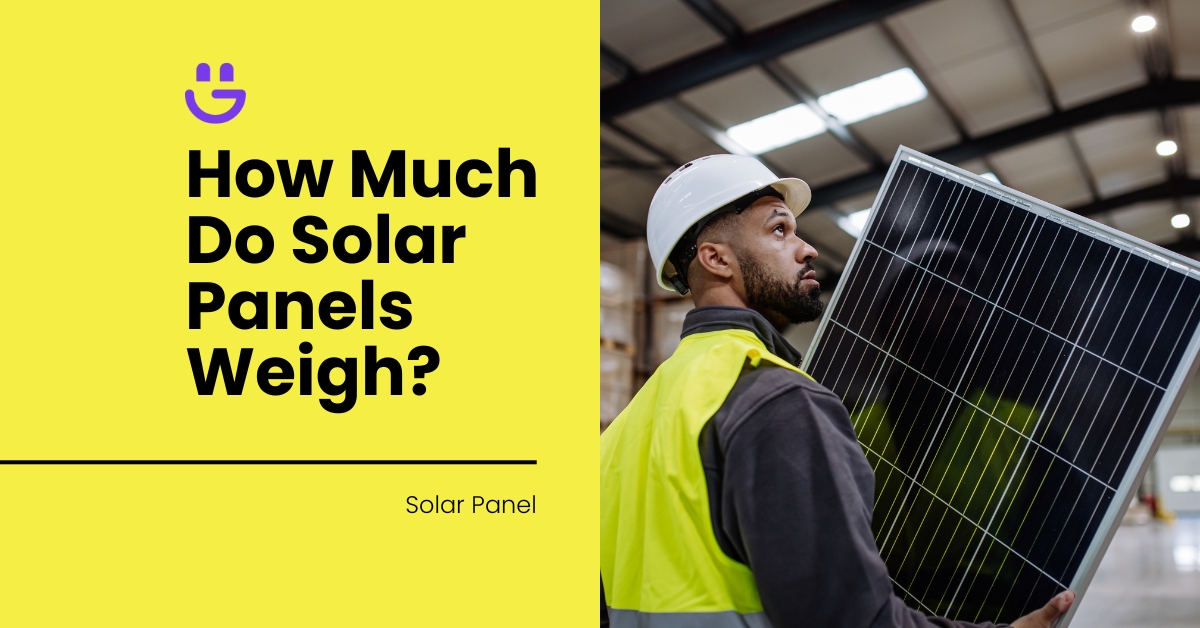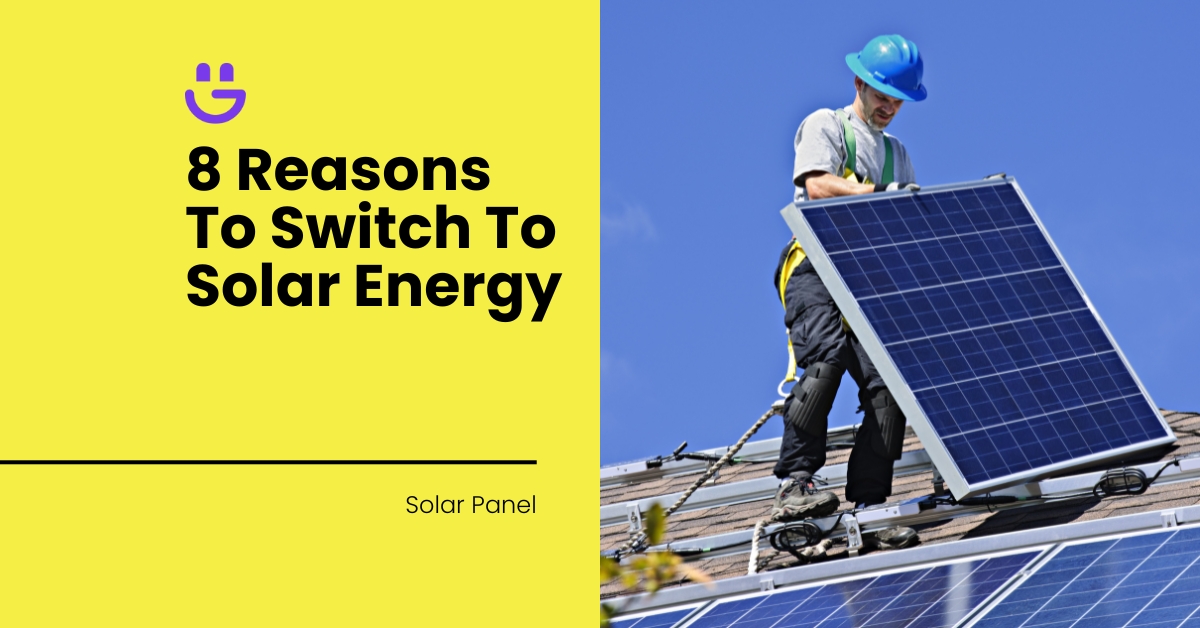Last Updated on November 14, 2025
Solar panels can weigh anything between 12 kg and 22 kg, depending on the type of panels you decide on.
When deciding on a solar system, the weight of the solar panels is an important consideration. Understanding how much solar panels weigh ensures that your roof or mounting structure can fully support the system.
To help you make a more informed decision, let’s explore this topic in more detail.
Contents
What Is the Average Weight of Solar Panels?
On average, solar panels weigh 12-22 kg each. However, this weight can differ depending on the type of solar panel you choose as well as the manufacturer. Here are some of the average weights of the most common types of solar panels:
Monocrystalline solar panels
Monocrystalline solar panels weigh roughly 18-22 kg and are ideal for smaller installations and areas with less sunlight. This makes them one of the most efficient types of solar panels.
Monocrystalline panels are best for homeowners and businesses who value efficiency over cost. They are also best suited for sloped, tiled, metal or asphalt shingle roofs. However, keep in mind that the appearance of these solar panels can be a drawback since they are bulkier in nature.
Polycrystalline solar panels
Polycrystalline solar panels weigh approximately 18-20 kg and are one of the more cost-effective solar panel options. The good news is that they can last just as long as monocrystalline panels.
However, you won’t always get the same levels of efficiency and each solar panel will take up more space. As with monocrystalline solar panels, polycrystalline panels are also well suited to sloped, tiled, metal or asphalt shingle roofs.
Thin-film solar panels
The most lightweight option is thin-film solar panels, which weigh roughly 12-15 kg. Recommended for commercial and small-scale applications with flat or metal roofs, thin-film solar panels are more flexible and affordable but aren’t as efficient as monocrystalline and polycrystalline panels.
What Factors Influence the Weight of Solar Panels?
There are several factors that influence the final weight of different solar panels:
Type of solar cells
- Monocrystalline panels: These are heavier panels because they’re made with single-crystal silicon cells.
- Polycrystalline panels: These panels are made with silicon crystals, which makes them lighter than monocrystalline panels.
- Thin-film panels: These panels are significantly lighter because they are made with amorphous silicon (a-Si) solar cells.
Materials used
- Glass: The type and thickness of the glass used to protect the solar cells can add really add to the weight of the solar panel. Tempered glass is commonly used for its durability.
- Frame: The material of the frame, which is usually aluminium, also adds to the weight. However, some manufacturers use plastic or composite materials to reduce weight.
- Backing: The backing material, which is made from polymer or metal, also contributes to the overall weight.
Size and output
Solar panel size and weight are directly related. Larger, commercial solar panels weigh more due to the increased number of solar cells, larger surface areas, and higher output compared to residential solar panels.
| Wattage Output (W) | Type | Average Weight (kg) |
|---|---|---|
| 250 | Monocrystalline/Polycrystalline | 18 – 20 |
| 300 | Monocrystalline/Polycrystalline | 18 – 22 |
| 400 | Monocrystalline/Polycrystalline | 22 – 24 |
| 100 | Thin-film | 5 – 7 |
| 200 | Thin-film | 7 – 10 |
| 300 | Thin-film | 10 – 12 |
Encapsulation materials
Materials used to encapsulate and protect solar cells, such as EVA (ethylene vinyl acetate) or PVB (polyvinyl butyral), can add to the weight.
Mounting system
Lastly, the type and weight of the mounting system can influence the overall weight when installing solar panels. Roof-mounted systems might use heavier mounts compared to ground-mounted systems.
What Are the Weight Considerations for Roof Installations?
When installing a solar panel system on a roof, several weight-related factors need to be considered to maintain the structural integrity of the building:
- Load-bearing capacity: The roof must be able to support the additional weight of the solar panels, including the mounting system. This will require an assessment by a structural engineer.
- Roof age and condition: Older roofs or those in poor condition may need repairs or reinforcement to handle the weight of the solar panels.
- Roof type and material: Different roofing materials have different load-bearing capacities and may require specific mounting solutions. For example, tiled roofs might need special hooks or mounts to avoid damaging the tiles.
- Panel weight: Standard 60-cell solar panels typically weigh between 18kg and 22 kg each. The total weight that’s added to the roof will depend on the number of panels you need to install to meet your energy requirements.
- Mounting system: The weight of the mounting system itself also needs to be considered. Roof-mounted systems can vary in weight depending on the material and design.
- Distributed load: Solar panel weight is distributed over a large area, which helps spread out the loud. However, the specific load distribution will depend on the layout of the panels and the mounting system.
- Wind and snow loads: In regions with significant wind or snow, additional considerations are necessary. Wind loads can exert additional force on the panels and mounting system, while snow can add extra weight. Both factors must be included in the structural assessment.
What Are the Weight Considerations for Ground Installations?
For a solar panel system installed on the ground, there are also several weight considerations to keep in mind:
- Ground mounts: Ground-mounted systems require robust frames and supports to hold the panels securely. These frames can add substantial weight to your solar panel system and must be designed to withstand environmental factors such as wind and snow loads.
- Material: Solar panel frames are often made from galvanised steel or aluminium, which provides strength while minimising additional weight.
- Concrete footings: For a heavier solar panel system or locations with high wind or seismic activity, concrete footings may be required to anchor the mounting structure securely. This adds weight and cost to the installation but provides much-needed stability.
- Driven piles: An alternative to concrete is driven piles, which can be used where soil conditions allow. These are metal rods driven into the ground, offering a stable and lighter-weight foundation for each solar panel.
- Soil type: The weight-bearing capacity of your soil affects the type of foundation you need. Sandy or loose soils may require deeper or more substantial foundations.
- Terrain slope: Sloped terrains may need additional engineering to ensure the stability of the solar panel mounting system, potentially adding to the overall weight and complexity of the system.
- Accessibility and maintenance: The layout of ground-mounted systems should allow for easy access for maintenance and cleaning. This may influence the spacing and height of the panels, which indirectly affect the structural requirements and weight considerations.
FAQs
What are the most lightweight commercial solar panels?
When selecting commercial solar panels, thin-film panels are a popular option because they’re lighter than traditional silicon panels. However, keep in mind that you may need more panels to achieve the same level of output as you would with other solar panel variations.
What type of roof is best suited to solar panels?
If you plan to install monocrystalline or polycrystalline solar panels, sloped, tiled, metal or asphalt shingle roofs are best. If you’re going the route of thin-film solar panels, a flat or metal roof would work best.
How do I know if I need a mounting system for my solar panels?
There are several reasons why you may need a mounting system for your solar panels:
- You’re installing a solar system on a flat roof.
- You want to better secure your solar panels on your roof and protect them from the elements on the ground.
- You want to distribute the weight of your solar panels more evenly across your roof.
- You’ll need to be able to adjust the angle or tilt of your panels.
Final Thoughts
You may not have thought that the weight of solar panels makes much of a difference to your system, but it’s an essential consideration.
Factoring in the weight of solar panels ensures your roof can handle the load of your solar system and that you invest your money as wisely as possible.
Ready to install solar panels and experience all the benefits that renewable energy has to offer? The Eco Happy team is ready to provide you with all the guidance you need as well as a competitive quote.
If you’re searching for affordable commercial or residential solar panels, contact us for a quote today.






Tom Allen
Solar Expert